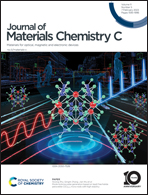Fluorescent phosphine oxide-containing hyperbranched polyesters: design, synthesis and their application for Fe3+ detection†
Abstract
Herein, fluorescent phosphine oxide-containing hyperbranched polyesters (HBPs) were synthesized via the solvent-free polycondensation of 3-((4-((bis(hydroxymethyl)phosphoryl)methyl)phenethyl)thio) propanoic acid (BHPA) or its methyl ester derivative (MBHP) by adding trimethylolpropane as the core for the first time. As a clusteroluminogen (CLgen), the hyperbranched polyesters (HBPn, n = 1–4) carrying no conventional chromophores exhibited bright blue fluorescence under the irradiation of 365 nm ultraviolet light. This photoluminescence was attributed to the clustering of electron-rich moieties (i.e., C![[double bond, length as m-dash]](https://www.rsc.org/images/entities/char_e001.gif) O, P
O, P![[double bond, length as m-dash]](https://www.rsc.org/images/entities/char_e001.gif) O and OH). HBP2 in dimethylformamide showed clear concentration-enhanced emission (CEE) as well as excitation-dependent emission (EDE) characteristics. In addition, HBP2 was proved to be a selective and sensitive sensor for Fe3+ detection due to its good linearly fluorescence quenching response with a low detection limit (0.59 μM).
O and OH). HBP2 in dimethylformamide showed clear concentration-enhanced emission (CEE) as well as excitation-dependent emission (EDE) characteristics. In addition, HBP2 was proved to be a selective and sensitive sensor for Fe3+ detection due to its good linearly fluorescence quenching response with a low detection limit (0.59 μM).



 Please wait while we load your content...
Please wait while we load your content...